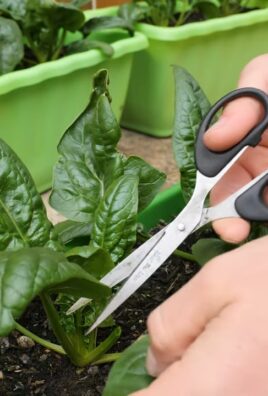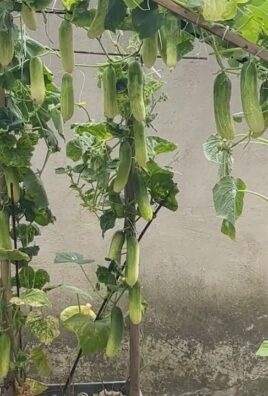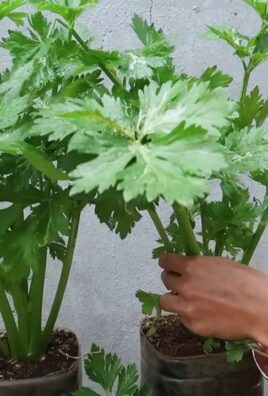Grow Ginger at Home: Imagine stepping into your kitchen, needing a touch of zesty warmth for your stir-fry or a soothing remedy for a scratchy throat, and simply reaching into your own backyard to harvest fresh ginger. Sounds dreamy, right? Well, it’s more achievable than you think! For centuries, ginger has been prized not only for its culinary versatility but also for its medicinal properties, playing a vital role in traditional medicine across Asia and beyond. From ancient Ayurvedic practices to modern-day kitchens, ginger’s potent flavor and health benefits have made it a staple ingredient.
But why rely on store-bought ginger when you can easily cultivate your own supply? I’m here to tell you that growing ginger at home is surprisingly simple, even if you don’t have a sprawling garden. This DIY guide will unlock the secrets to successfully growing ginger, offering practical tips and tricks that will transform your green thumb aspirations into a fragrant, flavorful reality. Whether you’re a seasoned gardener or a complete beginner, I’ll walk you through the entire process, from selecting the perfect rhizome to harvesting your very own homegrown ginger.
Ready to ditch the grocery store ginger and embark on a rewarding gardening adventure? Let’s dive in and discover how easy it is to grow ginger at home!

Growing Ginger at Home: Your Comprehensive DIY Guide
Hello dear garden friends! Have you ever wondered how you can grow your own ginger at home? It’s easier than you think and incredibly rewarding. Fresh ginger straight from your own garden or pot – what could be better? In this article, I’ll show you step by step how you can easily do it yourself. Let’s go!
What You Need: The Right Preparation
Before we get started, it’s important that we have everything prepared. Here is a list of the things you’ll need:
- A piece of ginger root (rhizome): Preferably from an organic store, as conventional ginger is often treated with growth inhibitors. Make sure the root looks plump and healthy and ideally already has small green buds.
- A container: A pot with a diameter of at least 20 cm and good drainage is ideal. Ginger needs space to spread out.
- High-quality potting soil: Well-draining, nutrient-rich soil is important. You can also mix potting soil with some compost.
- Water: For watering, of course!
- A bright location: Ginger loves light, but not direct midday sun.
- Optional: A spray bottle for humidity.
Step-by-Step Guide: How to Plant Your Ginger
Now that we have everything, we can start planting. Don’t worry, it’s really easy!
1. Prepare the ginger root:
- If your ginger root already has small green buds, great! If not, place it in lukewarm water for a few hours. This wakes it up and promotes growth.
- You can also cut the ginger root into several pieces if it’s large. Make sure each piece has at least one bud. Let the cut surfaces dry for a few hours before planting to prevent rot.
2. Prepare the pot:
- Fill the pot with potting soil, but leave about 5 cm of space to the rim.
- Press the soil down lightly.
3. Plant the ginger:
- Place the ginger root (or the pieces) horizontally on the soil. The buds should point upwards.
- Cover the root with about 2-5 cm of soil.
- Press the soil down lightly.
4. Watering:
- Water the soil thoroughly until it’s moist, but not soaked.
- Let the excess water drain away.
5. The right location:
- Place the pot in a bright location, but avoid direct midday sun. An east or west-facing window is ideal.
- Ginger likes it warm, so make sure the temperature does not fall below 20°C.
The Care: How to Keep Your Ginger Happy
After planting, proper care is crucial. Here are a few tips to help your ginger thrive:
- Watering: Water regularly, but avoid waterlogging. The soil should always be slightly moist. Check the moisture by sticking your finger about 2 cm deep into the soil.
- Humidity: Ginger loves high humidity. Spray the leaves regularly with water, especially in winter when the heating air is dry.
- Fertilizing: Fertilize your ginger every few weeks with an organic liquid fertilizer. This gives it the nutrients it needs to grow.
- Repotting: If the pot becomes too small, repot the ginger into a larger pot. This is usually the case after about a year.
- Pests and diseases: Ginger is relatively resistant to pests and diseases. However, watch out for signs of aphids or spider mites. If you spot any, treat them with a natural insecticide.
The Harvest: When is the Ginger Ripe?
The wait is over! After about 8-10 months, you can harvest your own ginger.
- When to harvest? You can tell the ginger is ripe when the leaves turn yellow and die back.
- How to harvest? Dig the entire plant out of the pot. You can either harvest the entire root or cut off a part of it and replant the rest.
- Storage: Fresh ginger keeps in the refrigerator for about 2-3 weeks. You can also freeze or dry it.
Common Problems and Solutions
Problems can also arise when growing ginger. Here are a few common problems and how you can solve them:
- Yellow leaves: Yellow leaves can be a sign of overwatering, nutrient deficiency, or too little light. Check your watering habits, fertilize the ginger, and move it to a brighter location.
- No growth: If your ginger isn’t growing, it could be due to low temperatures, too little light, or poor soil. Provide warmer temperatures, more light, and nutrient-rich soil.
- Rot: Rot often occurs with overwatering. Make sure the soil is well-draining and don’t water too much.
Additional Tips and Tricks
Here are a few more tips that can help you with growing ginger:
- Sprouting ginger in water: You can also sprout a ginger root in water before planting it in soil. Place the root in a glass of water so that the lower half is covered. Change the water regularly. After a few weeks, roots should form.
- Growing ginger outdoors: In mild climates, you can also grow ginger outdoors. Choose a semi-shady location and make sure the soil is well-draining.
- Ginger as a houseplant: Ginger is not only a useful plant but also a beautiful houseplant. With its green leaves, it brings a tropical flair to your home.
Why You Should Grow Ginger Yourself
There are many reasons why you should grow ginger yourself:
Relaxation: Gardening is a relaxing and satisfying activity.
Fresh ginger: You always have fresh ginger on hand when you need it.
Organic quality: You know exactly what’s in your ginger and can grow it without pesticides.
Sustainability: You reduce your ecological footprint by growing ginger yourself and not needing long transport routes.

Conclusion
So, there you have it! Growing ginger at home is not only achievable, but it’s also a deeply rewarding experience that connects you to the food you eat in a whole new way. Forget those bland, store-bought rhizomes that have been sitting on shelves for weeks. Imagine the vibrant, aromatic flavor of freshly harvested ginger, bursting with zest and ready to elevate your culinary creations. This isn’t just about saving a few dollars; it’s about embracing a sustainable practice, reducing your carbon footprint, and enjoying the unparalleled taste of homegrown goodness.
This DIY trick is a must-try for several compelling reasons. First, the flavor difference is undeniable. Homegrown ginger possesses a brighter, more intense flavor profile compared to its commercially available counterparts. Second, you have complete control over the growing process, ensuring that your ginger is free from harmful pesticides and chemicals. Third, it’s incredibly satisfying to nurture a plant from a simple rhizome to a thriving source of culinary delight.
But the journey doesn’t end with the basic method. Feel free to experiment with different varieties of ginger. Explore the nuances of ‘Chinese Ginger,’ known for its pungent flavor, or ‘Galangal,’ a close relative with a unique citrusy aroma. Consider growing your ginger in different types of containers, from traditional pots to raised beds, to see what works best for your space and climate. You can even try companion planting, pairing your ginger with herbs like turmeric or galangal, which thrive in similar conditions.
Don’t be afraid to get creative with your harvest, too. Beyond using it in your favorite recipes, consider making homemade ginger tea, candying it for a sweet treat, or even pickling it for a tangy condiment. The possibilities are truly endless.
We wholeheartedly encourage you to embark on this exciting adventure of growing ginger at home. It’s a simple, yet profound way to connect with nature, enhance your culinary skills, and enjoy the unparalleled flavor of fresh, homegrown ingredients.
And most importantly, we want to hear about your experiences! Share your tips, tricks, and triumphs in the comments below. Let us know what varieties you’ve tried, what challenges you’ve faced, and what delicious creations you’ve made with your homegrown ginger. Together, we can build a community of passionate home gardeners and unlock the full potential of this amazing spice. So, grab a ginger rhizome, get your hands dirty, and start growing your own flavorful adventure today! Let’s cultivate a world where fresh, homegrown ginger is within everyone’s reach.
Frequently Asked Questions (FAQ)
1. What kind of ginger should I use to start growing?
The best ginger to use for planting is fresh, plump ginger rhizomes from your local grocery store or farmers market. Look for rhizomes that are firm, with visible “eyes” or buds. Organic ginger is often preferred, as it’s less likely to have been treated with growth inhibitors. Avoid ginger that is shriveled, soft, or shows signs of mold. You can also source specific ginger varieties online from reputable seed companies if you’re looking for something beyond the standard grocery store options.
2. How long does it take to grow ginger at home?
Growing ginger requires patience. It typically takes around 8-10 months from planting to harvest. You’ll start to see sprouts emerge within a few weeks, but the rhizomes need ample time to mature and develop their full flavor. The exact timeframe can vary depending on your climate, growing conditions, and the specific variety of ginger you’re growing.
3. What are the ideal growing conditions for ginger?
Ginger thrives in warm, humid environments with partial shade. It prefers well-draining soil that is rich in organic matter. The ideal temperature range is between 65°F and 90°F (18°C and 32°C). Avoid exposing your ginger plants to direct sunlight, especially during the hottest part of the day, as this can scorch the leaves. Consistent moisture is crucial, but avoid overwatering, which can lead to root rot.
4. Can I grow ginger indoors?
Yes, you can absolutely grow ginger indoors, especially if you live in a colder climate. Choose a large pot with drainage holes and use a well-draining potting mix. Place the pot in a location that receives bright, indirect sunlight. You may need to supplement with artificial light if you don’t have enough natural light. Maintain consistent moisture and humidity levels by misting the plant regularly or using a humidifier.
5. How do I know when my ginger is ready to harvest?
You can start harvesting ginger after about 8-10 months, when the leaves begin to turn yellow and die back. You don’t have to harvest the entire plant at once. You can carefully dig around the edges of the pot or bed and harvest only the amount of ginger you need. The remaining ginger will continue to grow. For a more mature and pungent flavor, wait until the plant has completely died back before harvesting.
6. What are some common problems when growing ginger and how can I fix them?
One common problem is root rot, which is caused by overwatering. To prevent root rot, ensure that your soil is well-draining and avoid letting the soil stay soggy. Another problem is pests, such as aphids and spider mites. You can control these pests by spraying the plants with insecticidal soap or neem oil. Leaf spot diseases can also occur in humid conditions. Improve air circulation and remove any affected leaves to prevent the spread of disease.
7. Can I grow ginger from store-bought ginger that has already sprouted?
Yes, you can! In fact, this is a great way to get started. Just make sure the ginger is firm and healthy, and that the sprouts are green and vibrant. Plant it as you would any other ginger rhizome, and watch it grow.
8. What kind of fertilizer should I use for growing ginger?
Ginger benefits from regular feeding with a balanced organic fertilizer. Look for a fertilizer with an NPK ratio (nitrogen, phosphorus, potassium) of around 10-10-10 or 14-14-14. You can also use compost tea or worm castings to provide essential nutrients. Fertilize your ginger plants every 2-3 weeks during the growing season.
9. How do I store my harvested ginger?
Freshly harvested ginger can be stored in the refrigerator for several weeks. Wrap it in a paper towel and place it in a plastic bag to prevent it from drying out. You can also freeze ginger for longer storage. Peel and chop the ginger into small pieces, then freeze it in a single layer on a baking sheet. Once frozen, transfer the ginger to a freezer bag or container. Frozen ginger can be grated directly into your recipes.
10. Can I grow ginger in containers if I don’t have a garden?
Absolutely! Growing ginger in containers is a fantastic option for those without a garden. Choose a pot that is at least 12 inches deep and wide to allow the rhizomes plenty of room to grow. Use a well-draining potting mix and ensure that the pot has drainage holes. Place the container in a location that receives bright, indirect sunlight. With proper care, you can enjoy a bountiful harvest of homegrown ginger even in a small space.




Leave a Comment